|  | | | | 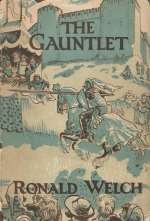

| | The Gauntlet
by Ronald Welch
First publication: 1951

 Peter gazed at it in silence. His head was feeling oddly numb, and the mist seemed to swirl around him with redoubled speed and thickness. Hardly realizing what he was doing, he slipped his right hand inside the heavy gauntlet, and this fingers groped inside the wide spaces, for it was far too large for his small hand. Peter gazed at it in silence. His head was feeling oddly numb, and the mist seemed to swirl around him with redoubled speed and thickness. Hardly realizing what he was doing, he slipped his right hand inside the heavy gauntlet, and this fingers groped inside the wide spaces, for it was far too large for his small hand.
 From behind there came the thud of hooves, a shout, shrill and defiant, the clang of metal on metal, and then a confused roar of sounds, shouts, more hoof-beats, clang after clang, dying away into the distance as suddenly as they had come. The gauntlet slipped from Peter’s hand, and he shook himself as if he had just awakened. From behind there came the thud of hooves, a shout, shrill and defiant, the clang of metal on metal, and then a confused roar of sounds, shouts, more hoof-beats, clang after clang, dying away into the distance as suddenly as they had come. The gauntlet slipped from Peter’s hand, and he shook himself as if he had just awakened. 
| |
| | | | |

 | | | | 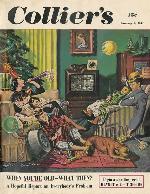

| | “Such Interesting Neighbors”
by Jack Finney
First publication: Collier’s, 6 Jan 1951

Al Lewis and his wife Nell have new neighbors, an inventor who talks of time travel from the future and his wife Ann.

The story was the basis for the second episode of Science Fiction Theater and also Spielberg’s Amazing Stories. But Ann walked straight into that door and fell. I couldn’t figure out how she came to do it; it was as though she expected the door to open by itself or something. That’s what Ted said, too, going over to help her up. “Be careful, honey,” he said, and laughed a little, making a joke of it. “You’ll have to learn, you know, that doors won’t open themselves.” But Ann walked straight into that door and fell. I couldn’t figure out how she came to do it; it was as though she expected the door to open by itself or something. That’s what Ted said, too, going over to help her up. “Be careful, honey,” he said, and laughed a little, making a joke of it. “You’ll have to learn, you know, that doors won’t open themselves.” 
| |
| | | | |

 
 | | | | 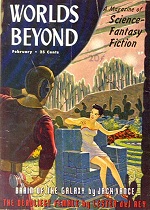

| | “Like a Bird, Like a Fish”
by H.B. Hickey
First publication: Worlds Beyond, Feb 1951

 When a strange ship crashes in Guadalajara, the villagers call Father Vincent. When the priest realizes that the visitors are lost and their ship is broken, he calls Pablo, who can fix anything (although generally mañana). And when everyone realizes that the visitors, who have already conquered their own realm where time-is-space and vice versa, mean to conquer Earth next (after all, Earthlings make good food), it seems too late to call anyone. When a strange ship crashes in Guadalajara, the villagers call Father Vincent. When the priest realizes that the visitors are lost and their ship is broken, he calls Pablo, who can fix anything (although generally mañana). And when everyone realizes that the visitors, who have already conquered their own realm where time-is-space and vice versa, mean to conquer Earth next (after all, Earthlings make good food), it seems too late to call anyone. Father Vincent was sorry that the villagers had called him. They should have set the fire. But it was too late. Father Vincent was sorry that the villagers had called him. They should have set the fire. But it was too late.
 “You will come in peace?” he asked, his voice beginning to tremble. “You will do no harm?” “You will come in peace?” he asked, his voice beginning to tremble. “You will do no harm?” 
| |
| | | | |

 
 
 | | | | 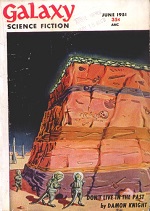

| | “Don’t Live in the Past”
by Damon Knight
First publication: Galaxy, Jun 1951

 A future transportation system goes awry, which results in flangs, tweedledums, collapsed flooring, argo paste, and mangels (yes, especially mangels) being delivered to the homes and business places of persons in a past century. Moreover, it’s quite possible that civilization down the line (including Bloggett’s own time!) will be altered. When the buck finally stops, the buck-kickers have decided that it’s up to Ronald Mao Jean-Jacques von Hochbein Mazurin to travel back and set things right. A future transportation system goes awry, which results in flangs, tweedledums, collapsed flooring, argo paste, and mangels (yes, especially mangels) being delivered to the homes and business places of persons in a past century. Moreover, it’s quite possible that civilization down the line (including Bloggett’s own time!) will be altered. When the buck finally stops, the buck-kickers have decided that it’s up to Ronald Mao Jean-Jacques von Hochbein Mazurin to travel back and set things right. The mathematicians are still working on that, Your Honor, and the best they can say now is that it was probably somewhere between the mid-Twentieth Century and the last Twenty-First. However there is a strong possibility that none of the material reached any enclosed space which would attract it, and that it may all have been dissipated harmlessly in the form of inconruent molecules. The mathematicians are still working on that, Your Honor, and the best they can say now is that it was probably somewhere between the mid-Twentieth Century and the last Twenty-First. However there is a strong possibility that none of the material reached any enclosed space which would attract it, and that it may all have been dissipated harmlessly in the form of inconruent molecules. 
| |
| | | | |

 | | | | 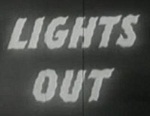

| | Lights Out
created by Fred Coe
First time travel: 2 Jul 1951

 I wonder whether Lights Out was the earliest sf anthology tv show. The first four episodes were live broadcasts on New York’s WNBT-TV (NBC) starting on 3 Jun 1946. It was renewed by NBC for three seasons of national broadcast starting 26 Jul 1949, and I spotted at least two time-travel episodes. Some episodes have found their way to Youtube, although I watched “And Adam Beget” on Disk 5 of the Netflix offering. I haven’t yet listened to any of the earlier radio broadcasts. I wonder whether Lights Out was the earliest sf anthology tv show. The first four episodes were live broadcasts on New York’s WNBT-TV (NBC) starting on 3 Jun 1946. It was renewed by NBC for three seasons of national broadcast starting 26 Jul 1949, and I spotted at least two time-travel episodes. Some episodes have found their way to Youtube, although I watched “And Adam Beget” on Disk 5 of the Netflix offering. I haven’t yet listened to any of the earlier radio broadcasts.

The episode “And Adam Beget” came from a 1939 radio episode of Arch Oboler’s Plays, and it formed the basis for a 1953 Steve Ditko story, “A Hole in His Head,” in the Black Magic comic book.- And Adam Begot (2 Jul 1951) time warp to prehistoric past
- Of Time and Third Avenue (30 Dec 1951) from Bester’s story
 You don’t understand. Look at the short, hairy, twisted body—the neck bent, the head thrust forward, those enormous brows, the short flat nose . . . You don’t understand. Look at the short, hairy, twisted body—the neck bent, the head thrust forward, those enormous brows, the short flat nose . . . 

—from “And Adam Begot ”
| |
| | | | |

 
 
 | | | | 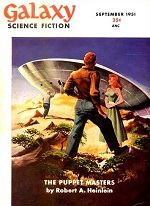 | | “The Biography Project”
by H.L. Gold (as by Dudley Dell)
First publication: Galaxy, Sep 1951

Many sf stories are called upon to provide one-way viewing of the past with no two-way interference, but few (not this one) will answer. There were 1,000 teams of biographers, military analysts, historians, etc., to begin recording history as it actually happened—with special attention, according to Maxwell’s grant, to past leaders of industry, politics, science, and the arts, in the order named. There were 1,000 teams of biographers, military analysts, historians, etc., to begin recording history as it actually happened—with special attention, according to Maxwell’s grant, to past leaders of industry, politics, science, and the arts, in the order named. 
| |
| | | | |

 
 
 
 
 
 | | | | 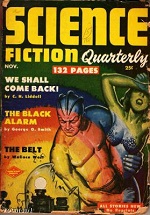 | | “Fool’s Errand”
by Lester del Rey
First publication: Science Fiction Quarterly, Nov 1951

Roger Sidney, a 23rd-century professor of paraphysics, travels back to ask an aging Nostradamus whether he truly wrote those uncannily accurate predictions that were not found until 1989, but Sidney overshoots his target and ends up searching for a young Nostradamus in a tavern in southern France.

“Fool’s Errand” was the second story del Rey wrote after moving to New York in 1944 where he rented a $3/week room near Ninth Avenue and Fifty-Seventh Street, but Campbell rejected the story for Astounding as being too obvious. It was another seven years before Roger Sidney would find his way into the pages of Science Fiction Quarterly, one of the new spate of 1950s sf magazines. If Nostradamus would accept the manuscript as being his, the controversy would be ended, and the paraphysicists could extend their mathematics with sureness that led on toward glorious, breathtaking possibilities. Somewhere, perhaps within a few feet, was the man who could settle the question conclusively, and somehow Sidney must find him—and soon! If Nostradamus would accept the manuscript as being his, the controversy would be ended, and the paraphysicists could extend their mathematics with sureness that led on toward glorious, breathtaking possibilities. Somewhere, perhaps within a few feet, was the man who could settle the question conclusively, and somehow Sidney must find him—and soon! 
| |
| | | | |

 
 | | | | 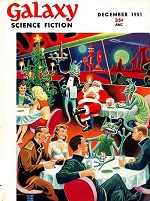

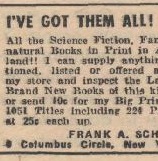 Columbus Circle then:

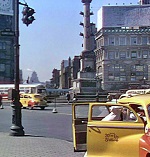 ...and now:

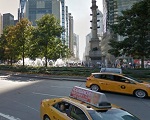 | | “Pillar to Post”
by John Wyndham
First publication: Galaxy, Dec 1951

Terence Molton, a double amputee, falls into a dope trance and wakens in the body of a Hymorell, a man in a flawed uptopian future that to Molton’s mind is immoral in many ways. As for his part, Hymorell is back in Terence’s body, building a machine to reverse the swap. Quite naturally, Terence feels some resistance to swapping back, a resistance that’s driving enough to give him some questionable morals himself.

One of the pleasures of reading old magazines is seeing the innocence of the ads, such as a 1.5-inch ad for Frank A. Schmid’s bookstore on Columbus Circle in New York. i’ve got them all! every one!, proclaims the ad, referring to sf books of the day. And perhaps they did!
 I sat up suddenly, feeling my legs, both of them. There wasn’t any pain. But there were two legs and two feet! I sat up suddenly, feeling my legs, both of them. There wasn’t any pain. But there were two legs and two feet!
 Then I did something I hadn’t let myself do in years—I burst into tears. Then I did something I hadn’t let myself do in years—I burst into tears. 
| |
| | | | |

 | | | | 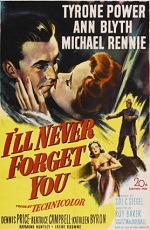

| | I’ll Never Forget You
aka The House in the Square, aka Man of Two Worlds
adapted by Ranald MacDougall
First release: 7 Dec 1951

John Balderston’s play Berkeley Square is updated to the 1950s where Peter Standish, now an atomic scientist, is once again transported back to the 18th century (unfortunately, not via a nuclear accident) to romance beautiful Kate Petigrew. Roger, I believe the 18th century still exists. It’s all around us, if only we could find it. Put it this way: Polaris, the North Star, is very bright, yet its light takes nearly fifty years to reach us. For all we know, Polaris may have ceased to exist somewhere around 1900. Yet we still see it, its past is our present. As far as Polaris is concerned, Teddy Roosevelt is just going down San Juan hill. Roger, I believe the 18th century still exists. It’s all around us, if only we could find it. Put it this way: Polaris, the North Star, is very bright, yet its light takes nearly fifty years to reach us. For all we know, Polaris may have ceased to exist somewhere around 1900. Yet we still see it, its past is our present. As far as Polaris is concerned, Teddy Roosevelt is just going down San Juan hill. 
| |
| | | | |

 
 
No Time Travel. Move along. |
“Reaping Time” by A. Bertram Chandler, Slant, Winter 1951 [despite title, no time travel ]

“Temple Trouble” by H. Beam Piper (paratime), Astounding, Apr 1951 [alternate timelines ]

“Excalibur and the Atom” by Theodore Sturgeon, Fantastic Adventures, Aug 1951 [despite title, no time travel ]

“Genesis” by H. Beam Piper (paratime), Future/Science Fiction Stories, Sep 1951 [alternate timelines ]

| |     |